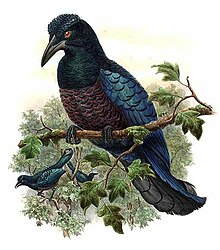Curl-crested manucode
| Curl-crested Manucode | |
|---|---|

| |
| Scientific classification | |
| Kingdom: | |
| Phylum: | |
| Class: | |
| Order: | |
| Family: | |
| Genus: | |
| Species: | M. comrii
|
| Binomial name | |
| Manucodia comrii Sclater, 1876
| |
The Curl-crested Manucode (Manucodia comrii) is a compact and large, approximately 43 cm long, bird-of-paradise with glossy purple, black and green plumage, red iris and crinkled yellowish-green upper breast and neck feathers. It has curled head feathering and twisted central tail feathers. Both sexes are similar with a slightly smaller female. It is the largest species of Manucode, and also the largest species in its family in terms of body size, weighing up to 450 grams[2] though its tail is shorter than the Black Sicklebill. They usually live in pairs in a single territory.
Endemic to Papua New Guinea, the Curl-crested Manucode is distributed to the Trobriand Islands and islands of the D'Entrecasteaux Archipelago. This species is also one of the largest and heaviest among birds of paradise. The diet consists mainly of fruits.
The British zoologist Philip Lutley Sclater named this species after Dr. Peter Comrie, who discovered the bird on Fergusson Island in 1874.
Although not the most vibrant in appearance, the curl crest manucode is certainly a vocally evolved species. In most birds, the trachea extends straight from the mouth to the lungs, whereas in this species, it extends towards the lower chest area and coils back through the abdominal cavity and then reaches the lungs, which gives the curl-crested manucode a characteristic fluting sound which is audible from a considerable distance. These vocalizations are common in courtship displays, where the birds spread their wings and raise their bodies in a strutting fashion. Manucode pairs also vocalize to defend their territories from invading pairs.[3]
A common species in its limited habitat range, the Curl-crested Manucode is evaluated as Least Concern on the IUCN Red List of Threatened Species. It is listed on Appendix II of CITES.
References
External links
- Curl-crested Manucode Video by the Cornell Lab of Ornithology
- BirdLife Species Factsheet
- [1]

